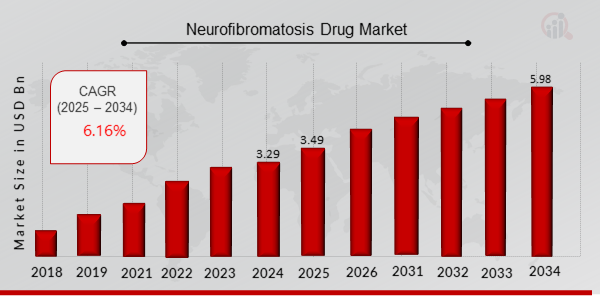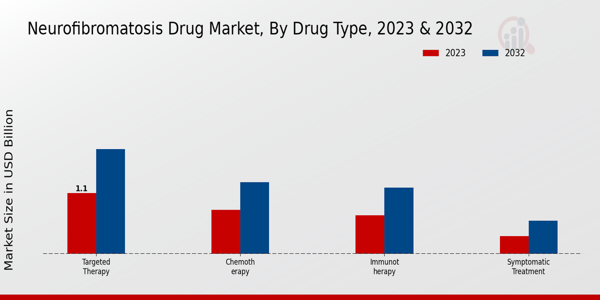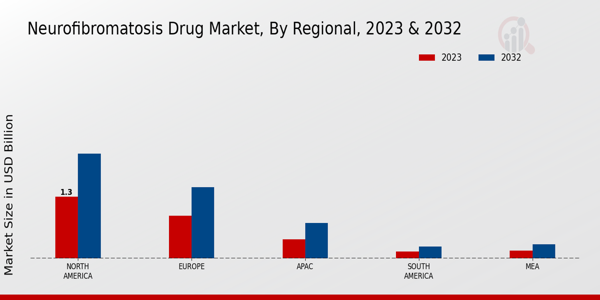Neurofibromatosis Drug Market Overview
As per MRFR analysis, the Neurofibromatosis Drug Market Size was estimated at 3.29 (USD Billion) in 2024. The Neurofibromatosis Drug Market Industry is expected to grow from 3.49 (USD Billion) in 2025 to 5.98 (USD Billion) till 2034, at a CAGR (growth rate) is expected to be around 6.16% during the forecast period (2025 - 2034).
Key Neurofibromatosis Drug Market Trends Highlighted
The Neurofibromatosis Drug Market is witnessing significant growth driven by several key factors. Increasing awareness about neurofibromatosis, a genetic disorder that affects nerve tissue, has propelled demand for effective treatments. Advancements in biotechnology and the growing focus on personalized medicine have led to the development of novel therapeutics that target the underlying genetic causes of the disease. Moreover, rising patient populations and improved diagnostic methods enhance early detection, further elevating the need for specialized drugs.
The ongoing research and development activities from pharmaceutical companies also play a crucial role in expanding the therapeutic options available.Opportunities within the market are substantial, especially for companies focused on niche therapies and orphan drug development. As regulatory agencies emphasize expedited approval pathways for drugs intended to treat rare conditions, companies can benefit from faster time-to-market. The increasing trend toward precision medicine opens avenues for tailored treatments based on individual genetic profiles. Collaborations between biotech firms and research institutions are expected to yield innovative solutions that address unmet needs in neurofibromatosis treatment.
Expanding healthcare access in developing regions may also lead to untapped markets, providing a chance for growth and expansion.Recent trends indicate a growing emphasis on comprehensive care that integrates pharmacological and non-pharmacological approaches. Integrated treatment strategies are becoming more popular, focusing on managing symptoms and enhancing the quality of life for patients. Furthermore, advancements in digital health technologies, such as telemedicine and remote monitoring, are transforming how care is delivered. Patients are increasingly empowered to engage in their treatment plans, creating a more patient-centered care model. The convergence of these trends is expected to shape the future landscape of the neurofibromatosis drug market.

Source: Primary Research, Secondary Research, MRFR Database and Analyst Review
Neurofibromatosis Drug Market Drivers
Increasing Prevalence of Neurofibromatosis
The increasing prevalence and incidence of neurofibromatosis (NF), together with other genetic factors, was a key factor encouraging the growth of the Neurofibromatosis Drug Market Industry. Neurofibromatosis is a group of genetically inherited disorders characterized by tumors in the great majority of the nerves. The increasing diagnosis rate of NF, coupled with better awareness among healthcare professionals and patients about the condition, has led to a higher number of individuals seeking medical treatment. With an estimated increase in the number of diagnosed cases across various regions, including North America, Europe, and Asia, there is an urgent demand for effective therapeutics targeting the various manifestations of this condition.As healthcare systems evolve, the ability to diagnose neurofibromatosis more accurately, often through genetic testing and advanced imaging techniques, has encouraged a proactive approach to treatment.
Moreover, as individuals diagnosed with NF age, the complexities associated with their symptoms often lead to severe complications, thereby increasing the need for specialized therapeutic options. In addition, support groups and patient advocacy organizations have been instrumental in amplifying awareness campaigns, ultimately reinforcing the necessity for effective drugs in the Neurofibromatosis Drug Market Industry.This heightened awareness has also led to increased research funding and support for the development of new treatments. As a result, pharmaceutical companies are investing more resources into creating targeted therapies and drug candidates to fulfill the unmet needs of patients, which in turn serves to drive market growth significantly.
Advancements in Drug Development
Innovations in drug development and technology are essential factors influencing the Neurofibromatosis Drug Market Industry. With increased investments in research and development, pharmaceutical companies are focusing on precision medicine and personalized treatments tailored to the specific genetic and phenotypic manifestations of neurofibromatosis. The advent of novel technologies such as gene therapy, monoclonal antibodies, and small molecule inhibitors is changing the drug discovery paradigms, providing new avenues for effective treatment alternatives.These advancements are expected to improve patient outcomes significantly and decrease the overall burden of the disease.
Growing Awareness and Education Programs
The rise in awareness programs and educational initiatives about neurofibromatosis is a crucial driver for the Neurofibromatosis Drug Market Industry. As more people recognize the signs and symptoms of NF, it leads to earlier diagnosis and treatment. Educational outreach conducted by healthcare providers and patient advocacy groups plays a significant role in disseminating critical information that facilitates timely medical intervention. This increased awareness encourages individuals to consult health professionals, thereby fostering a more informed patient population, which ultimately drives demand for effective neurofibromatosis therapies.
Neurofibromatosis Drug Market Segment Insights
Neurofibromatosis Drug Market Drug Type Insights
The Neurofibromatosis Drug Market is showing a promising upward trend, particularly in the Drug Type segment, which encompasses Targeted Therapy, Chemotherapy, Immunotherapy and Symptomatic Treatment. As of 2023, the market is valued at 2.92 USD Billion, highlighting the growing demand for effective therapeutic interventions for neurofibromatosis. Among these drug types, Targeted Therapy is anticipated to hold a majority share, with a valuation of 1.1 USD Billion in 2023, increasing to 1.9 USD Billion by 2032. This significant growth is driven by advancements in precision medicine that specifically target the genetic mutations associated with neurofibromatosis, offering more effective treatment options with fewer side effects.Chemotherapy, valued at 0.8 USD Billion in 2023 and expected to reach 1.3 USD Billion by 2032, has also been a critical component for managing aggressive forms of neurofibromatosis, especially in patients with malignant peripheral nerve sheath tumors.
Immunotherapy is gaining traction, with a current market value of 0.7 USD Billion, projected to grow to 1.2 USD Billion by 2032. This approach harnesses the body’s immune system to fight neurofibromatosis more effectively, showcasing its increasing importance in the treatment landscape. Lastly, Symptomatic Treatment, though smaller, valued at 0.32 USD Billion in 2023 and surging to 0.6 USD Billion in 2032, plays a vital role in managing the various symptoms associated with neurofibromatosis, ensuring improved quality of life for patients.Each of these segments contributes uniquely to the overall Neurofibromatosis Drug Market revenue, reflecting a diverse and evolving therapeutic landscape aimed at addressing the complexities of neurofibromatosis. The market growth in these drug types is fueled by ongoing research, increased awareness of the disease, and a stronger focus on tailored treatment solutions that meet patient needs effectively while presenting numerous opportunities for innovation and development within the industry.

Source: Primary Research, Secondary Research, MRFR Database and Analyst Review
Neurofibromatosis Drug Market Route of Administration Insights
Among the various routes, oral administration is widely preferred due to its ease of use and patient compliance, facilitating better access to medications. Intravenous and subcutaneous routes are significant as they allow for rapid drug absorption, especially needed in acute settings or to manage severe symptoms effectively.Topical administration also holds importance as it offers localized treatment, minimizing systemic side effects. The combination of these routes caters to the unique needs of patients, with each method supporting the overall goal of managing neurofibromatosis symptoms effectively. Understanding the Neurofibromatosis Drug Market segmentation is vital, as it helps identify growing opportunities driven by advancements in formulation technologies and patient-centered care approaches. The market reflects various trends and growth drivers, including increased awareness, ongoing research and the push for innovative therapies.However, challenges such as formulation complexities and regulatory hurdles remain present in this dynamic landscape. The availability of generic alternatives may also impact market dynamics, emphasizing the need for strategic planning within the Neurofibromatosis Drug Market industry.
Neurofibromatosis Drug Market Application Insights
The market is predominantly driven by applications related to Neurofibromatosis Type 1, Neurofibromatosis Type 2 and Schwannomatosis. Neurofibromatosis Type 1 holds a significant share of the market, primarily due to its higher prevalence and the pressing need for effective treatment options. Neurofibromatosis Type 2, while less common, presents substantial growth opportunities owing to advancements in targeted therapies and increasing awareness among healthcare providers.Schwannomatosis, although it accounts for a smaller portion of the market, is gaining attention due to the unique challenges it poses and the specialized treatments being developed. The rising prevalence of neurofibromatosis disorders and continuous growth in research and development endeavors in the pharmaceutical industry contributes to the expanding scope of the Neurofibromatosis Drug Market. With a focus on innovative therapy development and increasing patient awareness, the market is poised for notable growth in the upcoming years, reflected in improved Neurofibromatosis Drug Market data and statistics.
Neurofibromatosis Drug Market Patient Population Insights
The Neurofibromatosis Drug Market is projected to experience significant growth within the Patient Population segment, which comprises diverse demographics, including Pediatric, Adult and Geriatric populations. The Pediatric population plays a crucial role in this market due to the early onset of neurofibromatosis, which necessitates ongoing treatment strategies. Adults also significantly contribute to the market, often facing lifelong management of symptoms and complications associated with the disorder.Meanwhile, the Geriatric segment, though smaller, is becoming increasingly important as awareness and diagnosis improve, leading to potential new cases in older adults who were not diagnosed earlier in life. Trends such as growing research investment, increased awareness campaigns, and advancements in treatment options drive the market forward. However, challenges include the high costs associated with drug development and treatment accessibility. The diverse needs across these age groups present opportunities for tailored therapies, enhancing the overall Neurofibromatosis Drug Market statistics and driving market growth effectively.
Neurofibromatosis Drug Market Regional Insights
The Neurofibromatosis Drug Market is projected to exhibit significant growth across various regions, with North America holding the majority share, valued at 1.3 USD Billion in 2023 and anticipated to reach 2.2 USD Billion by 2032. This dominance is mainly due to an established healthcare infrastructure, increased research initiatives, and a rising patient population. Europe follows, with a valuation of 0.9 USD Billion in 2023, expected to grow to 1.5 USD Billion, benefiting from supportive regulatory frameworks and a high prevalence of neurofibromatosis.The Asia-Pacific (APAC) region, while smaller at 0.4 USD Billion in 2023, shows promise with its expected growth to 0.75 USD Billion, driven by increasing awareness and improving healthcare systems. South America and the Middle East Africa (MEA) represent smaller shares of the market, valued at 0.15 USD Billion and 0.17 USD Billion in 2023, respectively. Despite their modest sizes, these regions are gradually enhancing their healthcare services and investing in neurofibromatosis treatments, which could lead to substantial growth opportunities in the coming years.Understanding the Neurofibromatosis Drug Market segmentation is essential for stakeholders to harness market growth effectively and respond to evolving patient needs.

Source: Primary Research, Secondary Research, MRFR Database and Analyst Review
Neurofibromatosis Drug Market Key Players and Competitive Insights
The Neurofibromatosis Drug Market has been gaining significant attention due to the rising prevalence of neurofibromatosis disorders, characterized by the development of tumors on nerves and other associated complications. As awareness grows surrounding this group of genetic conditions, pharmaceutical companies are increasing their focus on innovative therapies and treatments that can improve patient outcomes. The competitive landscape in this market consists of various established players, each looking to leverage their own strengths in research and development as well as marketing strategies. Companies are actively engaged in collaborations, partnerships, and clinical trials to enhance their product offering and address the unmet medical needs of patients affected by neurofibromatosis.
This environment fosters competition that drives advancements and keeps the market dynamic, making it crucial for stakeholders to remain informed about market trends, regulatory developments, and emerging technologies.Pfizer has established a strong foothold in the Neurofibromatosis Drug Market thanks to its robust pipeline of therapies aimed at addressing the specific challenges associated with neurofibromatosis. The company's commitment to research and development is evident in its extensive clinical trials, which aim to evaluate the efficacy and safety of potential treatments for affected populations. Pfizer has positioned itself as a leader through its innovative approach to drug formulation and patient engagement strategies, ensuring that therapies not only meet regulatory requirements but also resonate with the needs of patients and healthcare providers. Its experience in the biopharmaceutical sector allows Pfizer to leverage its existing knowledge base and resources to accelerate the development of effective drugs, contributing to better management of the condition and overall quality of life for patients.Merck also plays a significant role in the Neurofibromatosis Drug Market, characterized by its diversified portfolio of pharmaceutical products and focus on advancing healthcare solutions. Merck's dedication to understanding neurofibromatosis and its implications on patient health has led to targeted research efforts aimed at developing effective treatment options.
The company’s strength lies in its scientific expertise and a collaborative ecosystem that supports innovation, often partnering with academic institutions and research organizations to foster advancements in drug development. Merck's established market presence and strategic investments in potential therapies enable it to adapt to changing market dynamics and regulatory landscapes, ensuring that it remains competitive in the ongoing quest to provide better treatment options for patients suffering from neurofibromatosis.
Key Companies in the Neurofibromatosis Drug Market Include
- Pfizer
- Merck
- Genentech
- Eli Lilly
- Teva Pharmaceuticals
- AbbVie
- Incyte
- Blueprint Medicines
- Vertex Pharmaceuticals
- Roche
- AstraZeneca
- Novartis
- BristolMyers Squibb
- Neurocrine Biosciences
- Sanofi
Neurofibromatosis Drug Market Industry Developments
Recent developments in the Neurofibromatosis Drug Market have shown significant activity among major players. Companies like Pfizer and Merck are expanding their research efforts into neurofibromatosis treatments, with Pfizer recently initiating clinical trials to evaluate a promising candidate drug. Meanwhile, Roche and Genentech are focusing on the biologics segment, aiming to leverage targeted therapies for better patient outcomes. In terms of mergers and acquisitions, notable movements include Eli Lilly’s acquisition of a biotech firm specializing in neurofibromatosis therapy, enhancing its RD capabilities in this area.
Similarly, Novartis and Vertex Pharmaceuticals have engaged in partnerships to explore new treatment options, reflecting a collaborative approach to innovation. In response to growing market demand, companies such as AbbVie and Sanofi have reported increased investments in their neurofibromatosis research portfolios, anticipating a rise in market valuation. This surge in activity underscores the heightened interest in therapeutics for neurofibromatosis as stakeholders recognize the potential for significant growth, aided by advancements in drug development and personalized medicine approaches. The market landscape remains dynamic, driven by both competitive innovation and strategic partnerships among key industry players.
Neurofibromatosis Drug Market Segmentation Insights
Neurofibromatosis Drug Market Drug Type Outlook
-
- Targeted Therapy
- Chemotherapy
- Immunotherapy
- Symptomatic Treatment
Neurofibromatosis Drug Market Route of Administration Outlook
-
- Oral
- Intravenous
- Subcutaneous
- Topical
Neurofibromatosis Drug Market Application Outlook
-
- Neurofibromatosis Type 1
- Neurofibromatosis Type 2
- Schwannomatosis
Neurofibromatosis Drug Market Patient Population Outlook
-
- Pediatric
- Adult
- Geriatric
Neurofibromatosis Drug Market Regional Outlook
-
- North America
- Europe
- South America
- Asia Pacific
- Middle East and Africa
| Report Attribute/Metric |
Details |
|
Market Size 2024
|
3.29 (USD Billion)
|
|
Market Size 2025
|
3.49 (USD Billion)
|
|
Market Size 2034
|
5.98 (USD Billion)
|
|
Compound Annual Growth Rate (CAGR)
|
6.16 % (2025 - 2034)
|
|
Report Coverage
|
Revenue Forecast, Competitive Landscape, Growth Factors, and Trends
|
|
Base Year
|
2024
|
|
Market Forecast Period
|
2025 - 2034
|
|
Historical Data
|
2020 - 2024
|
| Market Forecast Units |
USD Billion |
| Key Companies Profiled |
Pfizer, Merck, Genentech, Eli Lilly, Teva Pharmaceuticals, AbbVie, Incyte, Blueprint Medicines, Vertex Pharmaceuticals, Roche, AstraZeneca, Novartis, BristolMyers Squibb, Neurocrine Biosciences, Sanofi |
| Segments Covered |
Drug Type, Route of Administration, Application, Patient Population, Regional |
| Key Market Opportunities |
1. Rising patient awareness and advocacy, 2. Increasing clinical trials and research, 3. Growth in personalized medicine, 4. Advancements in gene therapy, 5. Emerging markets expansion |
| Key Market Dynamics |
1. Increasing prevalence of neurofibromatosis, 2. Growing R investment in treatments, 3. High demand for targeted therapies, 4. Rising awareness and diagnosis rates, 5. Regulatory support for orphan drugs |
| Countries Covered |
North America, Europe, APAC, South America, MEA |
Frequently Asked Questions (FAQ) :
The Neurofibromatosis Drug Market is expected to be valued at 5.0 USD Billion in 2034.
The Neurofibromatosis Drug Market is expected to exhibit a CAGR of 6.16% from 2025 to 2034.
By 2034, North America is projected to be the largest market, valued at approximately 2.2 USD Billion.
The Chemotherapy segment is expected to grow from 0.8 USD Billion in 2023 to 1.3 USD Billion in 2034.
Key players in the market include Pfizer, Merck, Genentech, Eli Lilly, and Teva Pharmaceuticals.
The Immunotherapy segment is anticipated to be valued at 1.2 USD Billion by 2034.
The APAC region is expected to grow to approximately 0.75 USD Billion by 2034.
The Targeted Therapy segment is projected to reach 1.9 USD Billion in 2034.
Challenges may include regulatory hurdles and high development costs for new therapies.
The Symptomatic Treatment segment is expected to be valued at 0.6 USD Billion in 2034.

















